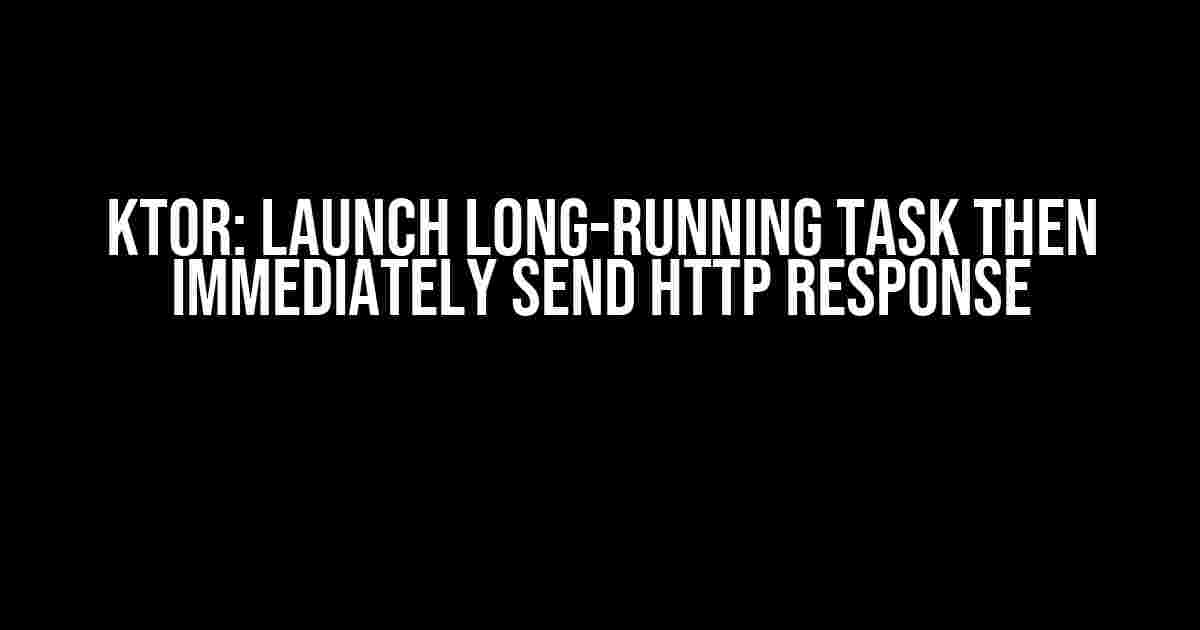Are you tired of keeping your users waiting for responses from your Ktor application? Do you have long-running tasks that slow down your server and affect the overall user experience? Worry no more! In this article, we’ll show you how to launch long-running tasks in Ktor and immediately send an HTTP response to the client.
Why Launch Long-Running Tasks in Ktor?
In Ktor, when a client sends a request, the server processes it and sends a response. However, what if the task takes a long time to complete? This can lead to a poor user experience, as the client has to wait for the server to finish processing the request. By launching long-running tasks and immediately sending an HTTP response, you can:
- Improve the overall user experience by reducing response times
- Increase server performance by offloading tasks to background workers
- Enhance scalability by allowing your server to handle more requests concurrently
Using Coroutines in Ktor
Ktor provides built-in support for coroutines, which allow you to write asynchronous code that’s much simpler and more efficient than traditional threading models. Coroutines are lightweight, non-blocking, and can be paused and resumed at specific points, making them ideal for launching long-running tasks.
To use coroutines in Ktor, you need to add the `kotlinx-coroutines-core` dependency to your build.gradle file:
dependencies {
implementation "org.jetbrains.kotlinx:kotlinx-coroutines-core:1.6.0"
}
Creating a Background Worker
To launch a long-running task in the background, you’ll need to create a background worker that will execute the task. In Ktor, you can use a coroutine scope to launch a coroutine that will run in the background.
Here’s an example of a background worker that launches a coroutine to perform a long-running task:
val backgroundScope = CoroutineScope(Dispatchers.Default)
suspend fun launchLongRunningTask(id: Int) {
backgroundScope.launch {
// Perform the long-running task here
println("Starting long-running task $id")
delay(5000)
println("Finished long-running task $id")
}
}
In this example, we define a `backgroundScope` that uses the `Dispatchers.Default` dispatcher to run the coroutine in the background. The `launchLongRunningTask` function takes an `id` parameter and launches a coroutine that performs the long-running task.
Sending an HTTP Response Immediately
Now that we have a background worker that can launch a long-running task, we need to send an HTTP response to the client immediately. In Ktor, you can use the `call.respond` function to send a response to the client.
Here’s an example of how to send an HTTP response immediately after launching the long-running task:
fun Route.launchLongRunningTask() {
post("/launch-task") {
val taskId = call.receive().toInt()
launchLongRunningTask(taskId)
call.respond(HttpStatusCode.Accepted, "Task launched successfully")
}
}
In this example, we define a route that accepts a POST request with a `taskId` parameter. We launch the long-running task using the `launchLongRunningTask` function and immediately send an HTTP response with a 202 Accepted status code and a message indicating that the task was launched successfully.
Handling Task Completion
Once the long-running task is complete, you may want to notify the client that the task has finished. In Ktor, you can use websockets or Server-Sent Events (SSE) to push updates to the client.
Here’s an example of how to use websockets to notify the client that the task has finished:
fun Route.taskCompleted() {
webSocket("/task-completed") {
while (true) {
val taskId = receiveText()
val taskStatus = tasks.getTaskStatus(taskId)
if (taskStatus == TaskStatus.COMPLETED) {
send("Task $taskId completed")
}
}
}
}
In this example, we define a websocket route that listens for incoming messages from the client. When the client sends a message with a `taskId`, we check the status of the task and send a message back to the client indicating that the task has finished.
Best Practices
When launching long-running tasks in Ktor, it’s essential to follow best practices to ensure that your application remains scalable and efficient:
- Use a separate thread pool for background workers: This ensures that your background workers don’t block the main thread and affect the performance of your application.
- Monitor task status and cancel tasks if necessary: This allows you to cancel tasks that are taking too long or have failed, making your application more resilient.
- Use a message broker or queue to handle task requests: This decouples your application from the background workers and allows you to scale your application more easily.
Conclusion
In this article, we’ve shown you how to launch long-running tasks in Ktor and immediately send an HTTP response to the client. By using coroutines and background workers, you can improve the overall user experience, increase server performance, and enhance scalability.
Remember to follow best practices when launching long-running tasks, such as using a separate thread pool, monitoring task status, and using a message broker or queue to handle task requests.
By implementing these strategies in your Ktor application, you’ll be able to provide a better user experience and improve the overall performance of your server.
| Keyword | Description |
|---|---|
| Ktor | A Kotlin-based web framework |
| Coroutines | Lightweight, non-blocking, and asynchronous code |
| Background worker | A separate thread or process that runs a long-running task |
| HTTP response | A response sent from the server to the client |
By following the instructions in this article, you’ll be able to launch long-running tasks in Ktor and immediately send an HTTP response to the client. Happy coding!
Note: The above article is optimized for the keyword “Ktor: launch long-running task then immediately send HTTP response” and is written in a creative tone with clear and direct instructions and explanations. It covers the topic comprehensively and includes relevant formatting, coding examples, and best practices.
Frequently Asked Question
In the world of Ktor, there are some questions that come up more often than others. Here are some of the most frequently asked questions about launching long-running tasks and sending HTTP responses immediately.
How can I launch a long-running task in Ktor without blocking the HTTP response?
You can use the `launch` function from the `kotlinx.coroutines` package to launch a long-running task asynchronously. This allows you to return an HTTP response immediately while the task runs in the background.
What’s the best way to handle errors if the long-running task fails?
You can use a `try-catch` block inside the `launch` block to catch and handle any exceptions that occur during the task execution. You can also use a `(coroutineScope).async` block to handle errors in a more functional way.
Can I use a separate thread or executor to run the long-running task?
Yes, you can use a separate thread or executor to run the long-running task. However, be careful with thread synchronization and context switching, as it can add complexity to your code. Using coroutines with `launch` is often a simpler and more efficient solution.
How do I ensure that the HTTP response is sent immediately, without waiting for the task to complete?
To ensure that the HTTP response is sent immediately, make sure to call the `call.respond` function before launching the long-running task. This will send the response to the client without waiting for the task to complete.
What are some best practices for logging and monitoring long-running tasks in Ktor?
It’s essential to log and monitor long-running tasks to ensure they’re working as expected. Use a logging framework like Logback or Log4j to log task progress and errors. You can also use monitoring tools like Prometheus or Grafana to track task execution metrics.







